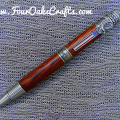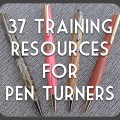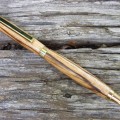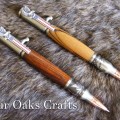Have you ever lost sight of the forest due to the many trees? Sometimes it’s good to just zoom out a bit, using a simple checklist to see what you need to get something accomplished. For this post, I’m providing a streamline list of essential things you need to turn pens.
A Checklist for Pen Turners
- Pen instructions – This is where you always need to begin. These instructions normally come with your pen kit, and they tell you exactly what you need to produce the pen in that particular kit. Here’s an example for a bolt action pen.
- Pen kit – includes pen tubes and all the components for the pen, including the ink refill. Purchase from a pen kit supplier like Woodcraft or Penn State Industries.
- Bushings – different for each kit. These are essential for getting the dimensions right on your pen.
- Drill bit – use for drilling hole for pen tubes. Size depends on pen kit.
- Barrel trimmer – comes with different sizes that match different tube sizes. Used to get the ends of your pen barrels flat and perpendicular with the glued in pen tubes.
- Turning tools – at a minimum, use a roughing gouge, skew, or scraper.
- Pen mandrel – Holds the pen blank and bushings. Mounts between your lathe’s head stock and tail stock.
- Lathe – Many people use a mini lathe or a lathe dedicated to pen turning.
- Dust mask – Need this at as a minimum, but preferred to also have a dust collector. You may need a respirator for turning some materials.
- Eye protection – Either ANSI rated safety glasses or face shield.
- Sharpener – Need some way to keep your tools sharp.
- Drill or drill press – Need a way to drill holes for pen tubes.
- Vises – you need some kind of vise, either a special pen turning vise or a bench vise to press the pen components in place.
- Clamps or pen drilling vise – these come in handy for holding your blanks to perform drilling operations or glueing in pen tubes.
- Bandsaw or other saw – need a way to cut pen blanks to different lengths. Use what you have. Maybe a tablesaw or handsaw.
- Sandpaper – At least need 120, 220, 320, & 400 grits. Some go further and use Micro Mesh which is a reusable, high-grit sanding cloth or pad.
- Glue – can use epoxy, but most use CA (a.k.a. super glue). Comes in thick, medium, and thin. Used to glue tubes into pen blanks.
- Finishing – Use either CA (advanced pen turner) or a friction polish (beginner pen turner).
- Presentation tube or box – Have a way to present your handmade gift.
I hope you have enjoyed my checklist for pen turners. If you want to learn more of the details, I encourage you to subcribe to my blog using the Subscribe Form. I have tutorials and tips for those wanting to get started turning pens or who want to pursue other adventures in woodworking.







Muito Bom. Agradeço sinceramente por compartilhar seus conhecimentos com aqueles que são curiosos como eu, e que sonham em ter o mínimo de habilidade para realizar um trabalho tão lindo.